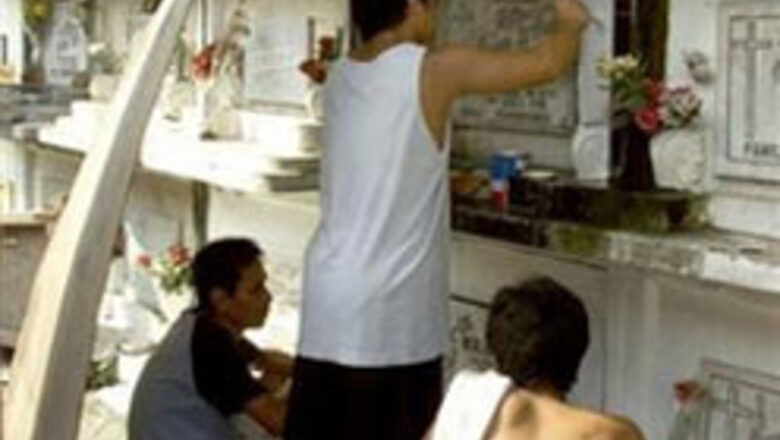
views
Manila: In the crowded sprawl of Manila, the living must compete for space with the dead.
Fortunately for Virginia Bernardino and hundreds of other slum dwellers who have moved into the largest cemetery in the Philippines, the deceased don't seem to mind.
"So far we have not seen any ghosts here," the soft-spoken Bernardino, 59, said with a chuckle. "I think that only happens in the movies. As the saying goes, we should fear not the dead but the living."
For years, Manila North Cemetery, a public graveyard in the centre of the capital of 12 million people, has been a thriving community for those evicted from their homes or flocking from the provinces for better opportunities in the big city.
After being forced from their state lot beside the cemetery to make way for a new graveyard, Bernardino and her husband have converted her mother-in-law's mausoleum into a home for their two sons, their wives and children.
Living conditions are basic but the residents manage some creature comforts.
Clothes hang from lines strung among the makeshift shacks and television sets flicker in a few homes with electricity stolen from nearby power lines.
The mainly Roman Catholic country, now home to more than 86 million people, has one of the fastest population growth rate in Asia at 2.36 per cent, or 5,400 babies born each day.
The incessant search for jobs and accompanying migration to cities has worsened problems of poverty, poor sanitation and urban decay.
A visit to Manila North Cemetery raises serious questions about government boasts that the economy is ready for take-off.
The squatters try to make a living by painting and cleaning gravestones and tombs. Others, like Bernardino's husband and children, have found work outside the cemetery in casual labor.
Small children run through the rock-filled lanes in bare feet, their faces and thin bodies covered with dirt.
"They already know that they should not make homes out of cemeteries," said Dr Eduardo Serrano, head of the Manila Health Department's preventable diseases division.
"It's dangerous to their health. The problem is they are being asked to leave but they keep on coming back," he said.
The country's housing shortage is expected to worsen as the population continues to grow to a projected 142 million by 2040.
PAGE_BREAK
The high birth rate is tied to the strong influence of the Catholic Church, which frowns on the use of contraceptives such as condoms and birth-control pills.
President Gloria Macapagal Arroyo, who survived an impeachment attempt last year and an alleged coup plot in February, relies on the support of the Church and shows no signs of reversing her emphasis on natural family planning over artificial methods.
On All Saints' Day and All Souls' Day, Catholic feasts on November 1 and 2, cemeteries across the Philippines come alive as people pay their respects to departed loved ones.
The holiday has also become a reunion for families, with graveyards transformed into picnic grounds for the two days.
But for Bernardino and her neighbors, the annual event could spell trouble.
Richard Navarra, one of the cemetery's caretakers, said the squatters would be asked to leave to make way for the crowds of visitors.
Manila North Cemetery, laid out in 1904, is the final resting place for a number of Filipino figures, from presidents and senators to popular actors.
Like their prominence in life, their tombs celebrate their passing with lavish splendor - a stark contrast to the lives of the poor seeking shelter among the graves.
And for many of those buried in public cemeteries, dying does not always mean resting in peace.
That is the lesson relatives of Herminia Lumindas have learned as they wait anxiously for the caretakers to remove a coffin from the tomb where they will bury her.
Many public cemeteries allow the use of certain grave sites for only five years.
"What can we do?" Luminda's nephew Adriano said as he lit a candle. "We don't have a choice because we do not have money to buy our own lot."














Comments
0 comment